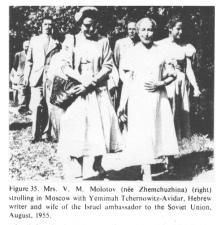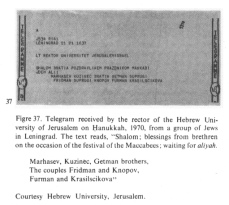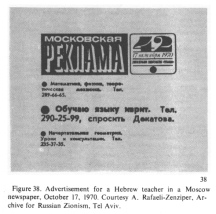[1920s and 1930s: Zionists
detect the suffering Jews in "Soviet Union"]
<The problems of Russian Jewry had exercised Jewish and
world opinion for many years before the overthrow of czarism
and were the subject (col. 496)
of relief and resettlement project, international protests,
and interventions. In the first years after the October
Revolution of 1917, when Zionist delegations from Russia
were still able to attend world Zionist conferences and
congresses (as in 1920 in London and 1921 in Carlsbad),
attention was given to the turmoil that the civil war and
revolutionary changes were causing to the large and vital
Jewish community in Soviet Russia, and Zionist congresses
adopted resolutions against the suppression of Zionism and
Hebrew by the Soviet regime.
The problem of Soviet Jewry found a place on the agenda of
the founding assembly of the *World Jewish Congress (W.J.C.)
in 1936, but the contemporary widespread sympathy for the
anti-Nazi stance of the Soviet Union and the belief that the
U.S.S.R. had tried to eradicate anti-Semitism and accord
national minority rights to its Jewish population muted
discussion of the question.
[1948-1953: "SU"
antisemitism and news in the Western world]
|
Encyclopaedia
Judaica (1971): Russia: Jews in "Soviet Union",
vol. 14, col. 497, Paul Yershov, U.S.S.R.
ambassador to Israel and doyen of the diplomatic
corps, greeting [racist Zionist] President
Weizmann and Mrs. Weizmann on the first Irael
Independence Day, May 1949
|
It was only in 1948, with the first indications of official
anti-Semitism in the U.S.S.R. (see *Anti-Semitism: in the
Soviet Bloc), that interest in the problem began to revive.
In spite of Soviet support for the establishment of a Jewish
state in Palestine, the gloom [[darkness]] of impending
[[coming]] developments in the situation of Soviet Jews
could already be felt; and although East European (col. 497)
delegations attended the W.J.C. assembly in 1948, misgivings
about Soviet Jews were tactfully mentioned in the assembly's
report. In general, however, until the events of the
"Black Years" (1948-53), little news of which reached the
outside world, it was assumed that no acute Soviet-Jewish
problem existed and that the difficulties confronting Jews
in the U.S.S.R. were intrinsically [[in fact]] the same as
those afflicting the general Soviet population. When the
campaign against "rootless cosmopolitans" began to sweep the
U.S.S.R. and Eastern Europe, however, culminating in the
"Doctors' Plot", a special world Jewish conference on the
situation of Soviet Jews was contemplated [[projected]]. The
W.J.C. assembly meeting in Montreux early in 1953 prepared a
document on the developments; the [[racist]] Zionist
movement held discussions; and other Jewish organizations
anxiously considered what steps might be taken if, as was
feared, the "Doctors' Plot" trial was used as an instrument
for wholesale repression of Soviet Jews. The death of Stalin
in March 1953 and the revocation of the charges against the
doctors ended this tense phase.
|
Encyclopaedia Judaica (1971): Russia: Jews in
"Soviet Union", vol. 14, col. 497, Mrs. V.M.
Molotov (née Zhemchuzhina) (right) strolling in
Moscow with Yemimah Tchernowitz-Avidar, Hebrew
writer and wife of the Israel ambassador to the
Soviet Union, August 1955 |
1956-1969. [Investigations
about the Jews in the "SU" by Salsberg, Levy - new
publications about "Soviet" Jews in the western world]
In 1956, after the 20th Congress of the Communist Party of
the Soviet Union, international opinion again began to stir
on behalf of Soviet Jews. Protests in the Warsaw Yiddish
Communist newspaper
Folkshtime
in April 1956 that the persecution of Soviet Jews had been
passed over in silence in Khrushchev's speech at the 20th
Congress, and the details
Folkshtime
released about the extent and virulence of Stalin's
anti-Jewish terror campaign, made the world realize that the
Jewish problem was still acute after almost 40 years of
Soviet rule. This came as a shock particularly to Jewish and
also non-Jewish Communists. Delegations from Western
Communist parties went to the U.S.S.R. to investigate the
truth.
J.B. Salsberg, a leading Canadian Communist, returned from
such a visit appalled [[frightened]]; he published a series
of articles on the subject in the American and Canadian
Communist press, including details of a meeting with the
Soviet leadership in the party with a group of old-time
Communists.
Hyman *Levy, a founder of the British Communist Party,
prepared a confidential report about his visit in Moscow;
the party executive regarded it as so shocking that only a
strictly censored version was released for publication. Levy
then published a pamphlet in 1958,
Jews and the National Question,
criticizing Soviet policy toward Jews in careful terms, and
he was expelled from the party.
In New York the Communist
Daily
Worker was closed down by the party and was
transformed into a weekly called the
Worker, because its
editors continued to criticize the U.S.S.R.'s treatment of
Jews.
Two pamphlets published in Yiddish in Tel Aviv in 1958,
"Jewish Communists on the Jewish Question in the Soviet
Union", reproduced articles and statements of Jewish
Communists in the West and in Poland.
Individual Jews and organizations in Western countries began
to pay more serious attention to Soviet Jews. A principal
problem was the paucity of reliable information. To meet
this need the newsletter
Jews in Eastern Europe was funded in 1958 in
London, edited by E. *Litvinoff; it subsequently appeared
three or four times a year and became a major source of
factual information about Soviet Jews.
At about the same time the Contemporary Jewish Library was
founded in London to collect and disseminate in photostats
source materials in Russian and other Soviet languages
relating to Jews in the U.S.S.R. under the title
Yevrei i Yevreyskiy Narod
("Jews and the Jewish People"). A branch of the Contemporary
Jewish Library opened in Paris published
Les Juifs en Europe de l'Est
and a monthly bulletin,
Les
Juifs en Union Soviétique. The Biblioteca Judía
Contemporanea in Buenos Aires published (col. 498)
Allà en la U.R.S.R.,
(col. 498-499)
and similar pamphlets were published in Italy. In New York,
Jewish Minorities Research, directed by Moshe Decter,
published monographs, pamphlets, reprints, and other
relevant materials on Soviet Jews, including
The Jews in the Soviet Union by Solomon M Schwarz
(1951);
The Jewish Problem in the
Soviet Union by B.Z. Goldberg (1961);
Jews in the Soviet Union
Census, 1959, edited by Mordecai Altshuler
(Jerusalem, 1963);
a study by the International Commission of Jurists in Geneva
(see below);
"Soixante ans du problème
juif dans la théorie et la pratique du bolchevisme"
by Marc Jarblum with a preface by Daniel *Mayer (in Revue
Socialiste, October 1964)
Soviet Jewry and Human
Rights by Isi Leibler (Human Rights Research
Publication, Victoria, Australia,March 1965;
two reports of the Socialist International (see below).
Particular popularity was achieved by the two eyewitness
accounts, Ben-Ami's (Arieh L. Eliav)
Between Hammer and Sickle
(Heb. 1965; Eng. 1967 and Elie Wiesel's
The Jews of Silence
(1966), which appeared in several languages and editions.
Interesting light was shed on Communist attitudes to the
Jewish problem in the U.S.S.R. by a series of polemical
exchanges in "Political Affairs", the ideological organ of
the U.S.Communist Party, in January 1965, October 1966, and
December 1966.
During the 1960s the problem of Soviet Jewry - the
discrimination against Jews in matters of language,
education, and religion; the dissemination of anti-Jewish
literature; the persecution of individual Jews, e.g., for
"economic crimes" or for Jewish communal activity; and the
denial to Jews of the right of emigration, particularly to
Israel, and the reunification of shattered families - became
a major issue in world Jewish and international discussion.
Almost every Jewish organization, Zionist and non-Zionist
alike, raised the problem as one of utmost importance to the
Jewish people, "second only to the existence and security on
Israel". Intellectuals on the left, Jews and non-Jews, held
special conferences to investigate the facts and issue
appeals to the Soviet government.
The first such conference took place in Paris in 1960 and
was attended by about 50 scholars, writers, academicians,
and parliamentarians from 16 Western and African countries.
Its opening session was addressed by Nahum *Goldmann and
Martin *Buber, and it received messages of support from
Albert Schweitzer, Francois Mauriac, Bertrand Russell,
former French president Vincent Auriol, Richard
Crossman, former Dutch premier Drees, Reinhold
Niebuhr, Supreme Court Justice William O. Douglas, Thurgood
Marshall, Daniel Mayer, and many others.
Subsequent conferences of this kind were held over the years
in Latin American countries, France, Scandinavia, Britain,
and Italy. They were attended and supported by intellectual
and moral authorities, including leading writers, poets, and
prominent fighters for human rights.
[1963: Foundation of the
"Conference on the Status of Soviet Jews" and of the
"American Jewish Conference on Soviet Jewry"]
Of particular significance was the Conference on the Status
of Soviet Jews in 1963, founded in New York by a meeting of
leading liberals, under the sponsorship of Justice Douglas,
Martin Luther King, Senator H. *Lehman, Bishop James Pike,
Walter Reuther, Norman Thomas, and Robert Penn Warren, which
issued an "appeal to conscience" and published many
documents containing factual material.
At the same time the Jewish community in the United States
established the American Jewish Conference on Soviet Jewry,
which encompassed [[involved]] all the major Jewish
organizations in the country (including the *American Jewish
Committee, which generally did not participate in (col. 499)
comprehensive Jewish frameworks).
This body sponsored
mass rallies, press conferences, and meetings with the White
House and State Department and also published factual
information on the current situation of the Jews in the
U.S.S.R. Similar activities were undertaken by central
Jewish bodies in their respective countries, such as the
Board of Deputies in Britain, the Conseil Représentatif des
Juifs de France, the Executive Committee of Australian
Jewry, etc.
[1967: Foundation of the
"Academic Committee on Soviet Jewry"]
In 1967 an Academic Committee on Soviet Jewry was formed in
the United States; its sponsors included Hans Morgenthau,
Daniel Bell, Saul Bellow, Lewis S. Feuer, Nathan Glazer,
Irving Howe, Alfred Kazin, Max Lerner, and Lionel Trilling.
The committee became an important source of information and
has issued, among other publications, a booklet entitled
Soviet Jewry: 1969,
consisting of papers read at a symposium by leading Soviet
experts.
[since 1962: Bertrand
Russell]
The moral struggle on behalf of Soviet Jews was given
considerable impetus by the interest shown in the problem by
the philosopher Bertrand Russell. His involvement began
early in 1962, when he sent a cable to Khrushchev, signed
jointly with François Mauriac and Martin Buber, appealing
for the full restitution of equal rights to Soviet Jews. He
also sponsored the publication of a statement on Soviet
Jewry signed by leading Nobel Prize laureates from different
countries. A private exchange of letters between Russell and
Khrushchev on this question followed until, to general
surprise, the Soviet authorities sought Russell's permission
to release part of the correspondence to the Soviet press
and agreed to his condition that he should similarly release
it to the Western press. It was published in Britain on Feb.
25, 1963, and in the U.S.S.R. on February 28, when it
appeared simultaneously in
Pravda and
Izvestiya and was broadcast by Radio
Moscow.
Khrushchev had defined Russell's appeals as part of a
campaign of "vicious slander" against the soviet Union. On
April 6, 1963, Russell replied at length repudiating this
insinuation and describing as "gravely disturbing" the fact
that some 60% of those executed for "economic offenses" in
the U.S.S.R. were Jews. Although the Soviet premier did not
reply to this letter, Russell continued his interventions on
behalf of individual Soviet Jews and the community as a
whole until age caused him to discontinue his public
activities in 1968.
[Russian Jewry mentioned at
the UN and in parliament houses]
The problem began to be reflected at the United Nations, in
parliaments, and in international bodies throughout the
world.
[[The main point about Herzl Israel and the Jews
The main point that Jewry is a religion and not a nation
is not detected by Encyclopaedia Judaica and is not
detected by the governments making statements on the Jews.
The fact is: It's not possible to convert a religion into
a nation because the religion itself has different
branches, and when the religion gets a bad reputation with
a racist state headed against all Arabs. By this many Jews
(the majority!) don't accept this racist Herzl military
Free Mason Zionist Herzl Israel as it is today with it's
cartridges and atomic bombs with the aim of a "Greater
Israel" from the Nile river to the Euphrates river against
all Arabs according to Herzl and 1st Mose chapter 15
phrase 18]].
The first discussion at the U.N. took place in 1961 at the
Subcommission on the Prevention of Discrimination and
Protection of Minorities, and has been a feature of U.N.
debates ever since. [[Palestinians could be mentioned since
1974 only]]. The matter was raised in 1962 at the General
Assembly's Social Committee by the Australian delegate, the
first time it was directly taken up by a member government
other than Israel. this development followed a report by a
delegation to the U.S.S.R. of the World Council of Churches,
which testified that Judaism experienced severe persecution
in that country.
In 1964, before a visit by Khrushchev to Sweden, Denmark,
and Norway was due to take place, the problem of Soviet Jews
was featured by the leading newspapers in all three
countries, and the Soviet premier's visit was "postponed".
The Council of Europe at Strasbourg, consisting of
parliamentary representatives from all democratic countries
in Europe and of official observers from Israel's Knesset,
several times debated the issue and established an
investigating committee to report on it. Its report served
as the basis for the council's appeal to all European
parliaments to raise their voice on behalf of Soviet Jewry.
In the parliaments of Britain, Ireland, the Netherlands,
Sweden, and many other countries, motions were signed by
many members (in Britain over 400 out of 630), and
governments were urged (col. 500)
to appeal to the Soviet Union on this matter. Both houses of
the U.S. Congress also debated the issue and several times
adopted almost unanimous resolutions on it. Leading
statesmen, such as President Eisenhower, President Kennedy,
and the British and Belgian premiers, as well as leaders of
socialist and other opposition parties in the West, took up
the issue in their encounters with Soviet statesmen and
public figures.
In 1964 the International Commission of Jurists in Geneva
published a special study entitled
Economic Crimes in the Soviet Union, which
proved the anti-Jewish character of Soviet policy in this
matter.
Gradually the current situation of the Jews in the Soviet
Union began to be prominently featured in the world press.
Such topics as the anti-Jewish riot at Malakhovka, near
Moscow, the mass gatherings of Jewish youth on Simhat Torah
at the synagogues of Moscow and Leningrad, the ban on
mazzot in the U.S.S.R.,
the virtual dissolution of the Moscow
yeshivah [[religious
Torah school]], the blood libel in the newspaper
Kommunist at Buinaksk,
Dagestan, Yevtushenko's poem "Babi Yar", and anti-Semitic
publications such as Kichko's "Judaism Without
Embellishment" [[without disguise]] were extensively
reported and commented upon in the principal newspapers the
world over and were the subject of sharp debates with Soviet
representatives in various bodies of the U.N. and other
international forums.
[[The western countries - which were lead by racist and
criminal "USA" - never accepted the rights of the Arabs.
Western countries supported the racist Jewish army, never
wanted to get to know about the Zionist aim of Herzl Israel
from Nile to Euphrates and detected Jewish Zionist racism
against Palestinians in the 1970s only when Palestinian
terrorist committed some heavy attacks on Jews in air planes
or on the Olympic games in Munich]].
National and international writers' congresses, as well as
PEN Club meetings, adopted resolutions against the
suppression of Jewish culture in the U.S.S.R. Some Communist
and pro-Soviet circles and press organs, particularly in
Italy, Canada, Britain, the United States, Austria,
Switzerland, Sweden, and Australia, openly criticized Soviet
discrimination against Jews.
[Student groups' agitation
for Soviet Jewry]
In the late 1960s Jewish student groups for the struggle for
Soviet Jewry sprang up in the [[criminal and racist]] United
States, mainly on the east and west coasts, and in Great
Britain, where demonstrations were stage, particularly at
Soviet diplomatic missions. The world Union of Jewish
Students (WUJS) organized a mobile exhibition illustrating
the plight of Soviet Jewry, and mass petitions were signed
by many thousands of Jewish and non-Jewish students.
PARTICIPATION OF [Herzl]
ISRAEL. [Agitation by Jews of Herzl Israel for Soviet
Jewry]
[[Delegates of racist Free Mason Zionist Herzl Israel hid
always their role as to be a satellite of the criminal "USA"
and hid the "Greater Israel" aim against the Arabs. Arabs or
Palestinians were not mentioned, this was the Jewish
solution of the Arab problem]].
Israel representatives were in the forefront of initiating
discussions on the problem in various U.N. bodies, the
Socialist International (which published two reports, in
1964 and in 1969, called
The
Situation of Jews in the U.S.S.R. and
Anti-Semitism in Eastern
Europe), the Council of Europe, etc.
In 1965 the first motion on Soviet Jewry was discussed in
the Knesset. Later the Knesset devoted several special
sessions to the situation of Soviet Jewry and made an appeal
to other parliaments to take up the issue. The problem was
repeatedly dealt with by the Israel press and broadcasting
service and in official and unofficial encounters by
Israel's leaders and diplomatic representatives with Soviet
diplomats and other personalities.
Emigration
drive action 1970-1971
|
|
Encyclopaedia
Judaica (1971): Russia: Jews in "Soviet Union",
vol. 14, col. 503, cable (telegram) from Russian
Jews 1970: Telegram received by the rector of
the Hebrew University of Jerusalem on Hanukkah,
1970, from a group of Jews in Leningrad.
|
|
Encyclopaedia
Judaica (1971): Russia: Jews in "Soviet Union",
vol. 14, col. 504, advertisement searching for
Hebrew teacher in Moscow of 17 October 1970
|
|
Encyclopaedia
Judaica (1971): Russia: Jews in "Soviet Union",
vol. 14, col. 503-504, advertisment of
solidarity 1970 for the emigration drive
|
|
Encyclopaedia
Judaica (1971): Russia: Jews in "Soviet Union",
vol. 14, col. 503, Russian Jewish immigrants on
25 March 1971
|
[Books from Soviet Jews in
racist Herzl Free Mason Herzl Israel]
In Israel the Hebrew writings of Soviet Jews, most of them
brought out clandestinely from the U.S.S.R., were published
as early as the 1950s and served as a powerful means of
reviving feelings of solidarity with Soviet Jewry. A
collection of the Hebrew poetry of Hayyim *Lenski and Elisha
*Rodin appeared in 1954 under the title
He-Anaf ha-Gaddu'a
("The Cut-off Branch"). In 1957 the first anonymous Hebrew
manuscript from the Soviet Union, called
El Ahi bi-Medinat Yisrael
("To My Brother in the State of Israel"), which was written
in an old-fashioned
maskil
style, and contained a diary on the "Black Years", was
published, first in the newspaper
Davar and then in book form. (Only after
the author's death in Kiev in 1968, was his name, Barukh
Mordekhai Weissman, revealed).
Under the pen name Sh. Sh. Ron, a Soviet Hebrew writer
described his own and his fellow Jews' experience in a (col.
501)
concentration camp in a smuggled-out booklet,
Me-Ever mi-Sham ("From
Over There", 1959). Unknown and unpublished poems by H.
Lenski, some of which were written in a concentration camp
in Siberia, somehow reached Israel and were published
posthumously in 1960 under the title
Me-Ever li-Nehar ha-Lethe
("From the Other Shore of the Lethe River"), together with
an introduction and postscripts by the poet's friends in
Israel.
A collection of Zionist poetry in its Russian original with
Hebrew translations,
Ha-Lo
Tishali (its Russian title "My Spring Will Come")
by an anonymous Soviet Jew, with an introduction by Y. Nadav
(describing how the poems were written by a member of a
clandestine [[racist]] Zionist group in a labour camp),
appeared in 1962.
A strong impact was made by Esther Feldman's
autobiographical
Kele
Beli Sugar ("Prison Without Bars", 1964), the story
of a Jewish woman in the Soviet Union whose husband (Joseph
Berger-Barzilai) was imprisoned for over 20 years as an
"enemy of the people" and then "rehabilitated".
Soviet Hebrew fiction published in Israel included a novel
about World War II,
Esh
ha-Tamid ("The Eternal Fire", 1966), written by a
writer who hid his identity under the pen name A. Tsefoni,
smuggled out of the U.S.S.R., and Abraham Friman's
monumental novel,
1919,
about the revolutionary years (1968); its first two parts
had been published in the 1930s and received the Bialik
price, whereas the third part was recently smuggled out of
the U.S.S.R. (the fourth part is still missing).
[Children education in
Herzl Israel with data about Soviet Jewry - and hatred
against Arabs]
Educational work to convey deeper knowledge of the history
and the current situation of Soviet Jewry was conducted over
the years in Israel's schools and army units in various
forms, including lectures, classes, a mobile exhibition,
etc. The Hebrew magazine
He-Avar
and various publications of the Israel section of the World
Jewish Congress have devoted themselves to research on
Soviet Jewish affairs.> (col. 502)
[[It can be admitted that the Jewish institutions in Israel
never mentioned the racist Jewish army and never mentioned
the rights of the Arabs. The Jewish children in Herzl Israel
were in fact educated in a hatred against the Arabs. And it
can be admitted that children in the "Soviet Union" got also
an education with facts about racist Zionist Free Mason
Herzl Israel. Only the solution was never found: Jewry is
not a nation, but a religion, and the foundation of a
"Jewish state" within the Arab landscape with the
announcement of borders from Nile to Euphrates river is a
trap of war
because Arab antisemitism is coming up to the antisemitism
which existed until 1945. Human rights should be signed]].
Bibliography
GENERAL WORKS
-- Institute of Jewish Affairs, London: Soviet Jewry (1971),
an extensive bibliography
-- L. Greenberg: The Jews in Russia, 2 vols. (1951)
-- S.W. Baron: The Russian Jew under Tsars and Soviets
(1964)
1772-1917
- J.S. Raisin: The Haskalah Movement in Russia (1915)
-- Dubnow, Hist Russ
-- J. Kunitz: Russian Literature and the Jews (1929)
-- I Levitats: The Jewish Community in Russia, 1772-1844
(1943)
-- J. Frumkin et al. (eds.): Russian Jewry 1860-1917 (1966)
-- V. Nikitin: Yevrei zemledeltsy (1887)
-- M.L. Usov: Yevrei v armii (1911)
-- L. Zinberg: Yevreyskaya periodicheskaya pechat v Rosii
(1915)
-- Yu. Gessen: Istoriya yevreyskogo naroda v. Rossii, 2
vols. (1925-26)
-- S.Y. Borovoy: Yevreyskaya zemledelcheskaya kolonizatsiya
v staroy Rossi (1928)
-- N. Buchbinder: Geshikhte fun der Yidisher Arbeter
Bavegung in Rusland (1931)
-- A. Levin: Kantonistn... 1827-1856 (1934)
-- S. Ginzburg: Historishe Verk, 3 vols. (1937-38)
-- B. Dinur: Bi-Ymei Milhamah u-Mahpekhah (1960)
1917-1971
-- International Military Tribunal: Trials of the Major War
Criminals, 4 (1950), 3-596
-- S.M. Schwarz: The Jews in the Soviet Union (1951)
-- idem: Yevrei v Sovietskom Soyuze s nachala vtoroy mirovoy
voyny (1966)
-- J. Tenenbaum: Race and Reich (1956), 347-70
-- B. West (ed.): Struggle of a Generation: The Jews under
Soviet Rule (1959)
-- idem: Hem Hayu Rabbim (1968)
-- L. Lénéman: La Tragédie des Juifs en U.R.S.S. (1959)
-- J.B. Schechtman: Star in Eclipse:Russian Jewry Revisited
(1961)
-- B.Z. Goldberg: The Jewish Problem in the Soviet Union
(1961)
-- E. Schulman: A History of Jewish Education in the Soviet
Union (1971)
-- E. Wiesel: The Jews of Silence (1966)
-- Gli ebrei nel' U.R.S.S. (1966)
-- Ben-Ami (A. Eliav): Between Hammer and Sickel (1967)
-- S. Rabinovich: Jews in the Soviet Union (Moscow, 1967)
-- L. Kochan (ed.): The Jews in Soviet Russia since 1917
(1970)
-- A. Dagan: Moscow and jerusalem (1971)
-- Jews in Eastern Europe (1958- )
-- S. Agursky: Di Yidishe Komisariatn un di Yidishe
Komunistishe Sekties (1928)
-- N. Gergel: Di Lage fun yidn in Rusland (1929)
-- A. Rafaeli (Zenziper): Eser Shenot Redifot (1930)
-- S. Dimanstein (ed.): Yidn in F.S.S.R. (1935)
-- L. Zinger: Dos Banayte Folk (1941)
-- L. Lestschinsky: Dos Sovetishe Idntum (1941) (col. 505)
-- M. Kahanovitch: Milhemet ha-Partizanim ha-Yehudim
be-Mizrah Eiropah (1954)
-- Y.A. Gilboa: Al Horvot ha-Tarbut ha-Yehudit bi-Verit
ha-Mo'azot (1959)
-- idem: The Black Years of Soviet Jewry (1971)
-- Ch. Chmeruk (ed.): Pirsumim Yehudiyyim bi-Verit
ha-Mo'azot (1961)
-- idem (ed.): A Shpigl oyf a Shteyn (1964)
-- A. Pomeranz: Di Sovetishe Harugey Malkhes (1962)
-- J. Levavi: Ha-Hityashevut ha-Yehudit be-Birobidzhan
-- J. Litvak, in: Gesher, 12 nos. 2-3 (1966), 186-217
-- M. Guri et al. (eds.): Hayyalim Yehudim be-Zivot Eiropah
(1967), 135-57
-- S. Nishmit, in: Dappim le-Heker ha-Sho'ah ve-ha-Mered,
series B. collection A (1969), 152-77
-- S. Redlich, in: Behinot, 1 (1970), 70-79
-- He-Avar (1952- ) (col. 506)
Sources
|
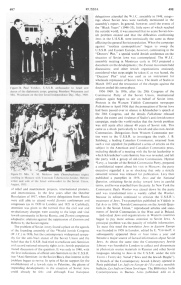
Encyclopaedia Judaica (1971): Russia: Jews in
"Soviet Union", vol. 14, col. 497-498
|
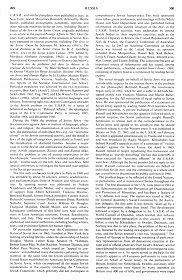
Encyclopaedia Judaica (1971): Russia: Jews in
"Soviet Union", vol. 14, col. 499-500 |

Encyclopaedia Judaica (1971): Russia: Jews in
"Soviet Union", vol. 14, col. 501-502 |
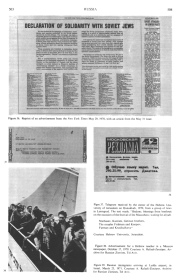
Encyclopaedia Judaica (1971): Russia: Jews in
"Soviet Union", vol. 14, col. 503-504 |
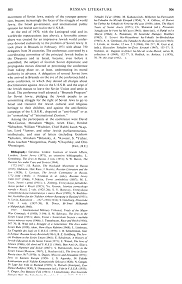
Encyclopaedia Judaica (1971): Russia: Jews in
"Soviet Union", vol. 14, col. 505-506 |





![Encyclopaedia Judaica (1971): Russia:
Jews in "Soviet Union", vol. 14,
col. 497, Paul Yershov, U.S.S.R. ambassador
to Israel and doyen of the diplomatic corps,
greeting [racist Zionist] President Weizmann
and Mrs. Weizmann on the first Irael
Independence Day, May 1949 Encyclopaedia Judaica (1971): Russia:
Jews in "Soviet Union", vol. 14,
col. 497, Paul Yershov, U.S.S.R. ambassador
to Israel and doyen of the diplomatic corps,
greeting [racist Zionist] President Weizmann
and Mrs. Weizmann on the first Irael
Independence Day, May 1949](EncJud_juden-in-SU-d/EncJud_Russia-band14-kolonne497-SU-botschafter-Yershov-m-Weizmann-1949-45pr.jpg)
